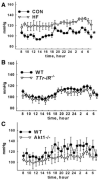Contribution of insulin and Akt1 signaling to endothelial nitric oxide synthase in the regulation of endothelial function and blood pressure
- PMID: 19342603
- PMCID: PMC2936913
- DOI: 10.1161/CIRCRESAHA.108.189316
Contribution of insulin and Akt1 signaling to endothelial nitric oxide synthase in the regulation of endothelial function and blood pressure
Abstract
Impaired insulin signaling via phosphatidylinositol 3-kinase/Akt to endothelial nitric oxide synthase (eNOS) in the vasculature has been postulated to lead to arterial dysfunction and hypertension in obesity and other insulin resistant states. To investigate this, we compared insulin signaling in the vasculature, endothelial function, and systemic blood pressure in mice fed a high-fat (HF) diet to mice with genetic ablation of insulin receptors in all vascular tissues (TTr-IR(-/-)) or mice with genetic ablation of Akt1 (Akt1-/-). HF mice developed obesity, impaired glucose tolerance, and elevated free fatty acids that was associated with endothelial dysfunction and hypertension. Basal and insulin-mediated phosphorylation of extracellular signal-regulated kinase 1/2 and Akt in the vasculature was preserved, but basal and insulin-stimulated eNOS phosphorylation was abolished in vessels from HF versus lean mice. In contrast, basal vascular eNOS phosphorylation, endothelial function, and blood pressure were normal despite absent insulin-mediated eNOS phosphorylation in TTr-IR(-/-) mice and absent insulin-mediated eNOS phosphorylation via Akt1 in Akt1-/- mice. In cultured endothelial cells, 6 hours of incubation with palmitate attenuated basal and insulin-stimulated eNOS phosphorylation and NO production despite normal activation of extracellular signal-regulated kinase 1/2 and Akt. Moreover, incubation of isolated arteries with palmitate impaired endothelium-dependent but not vascular smooth muscle function. Collectively, these results indicate that lower arterial eNOS phosphorylation, hypertension, and vascular dysfunction following HF feeding do not result from defective upstream signaling via Akt, but from free fatty acid-mediated impairment of eNOS phosphorylation.
Figures








Comment in
-
Mechanisms of vascular insulin resistance: a substitute Akt?Circ Res. 2009 May 8;104(9):1035-7. doi: 10.1161/CIRCRESAHA.109.198028. Circ Res. 2009. PMID: 19423861 Free PMC article. No abstract available.
References
-
- Kim JA, Montagnani M, Koh KK, Quon MJ. Reciprocal relationships between insulin resistance and endothelial dysfunction: molecular and pathophysiological mechanisms. Circulation. 2006;113:1888–1904. - PubMed
-
- Muniyappa R, Montagnani M, Koh KK, Quon MJ. Cardiovascular actions of insulin. Endocr Rev. 2007;28:463–491. - PubMed
Publication types
MeSH terms
Substances
Grants and funding
LinkOut - more resources
Full Text Sources
Medical
Molecular Biology Databases
Research Materials
Miscellaneous

